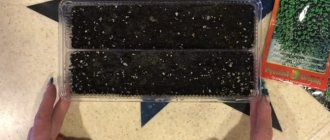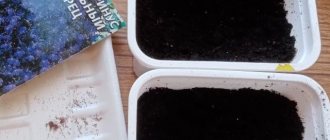Saxifraga is a ground cover perennial herbaceous unpretentious crop. In regions with cold winters it is grown as an annual. There are plants with pink, red, purple, yellow, and white flowers. It also has other names: Saxifraga, Rupture-grass. Such unusual names were obtained due to the fact that the flower crop can literally destroy rock. The most popular type: Saxifraga Arends (height about 10-20 cm), the species blooms, as a rule, in late spring, early summer, is winter-hardy and unpretentious, but does not tolerate drying out of the soil. In terms of care, Arends saxifrage is very unpretentious, you just need to water it periodically, preventing the soil from drying out. Loves open areas with loose, well-drained soil, but can be grown in light partial shade.
What do saxifrage seeds look like?
Photos of saxifrage seeds show that the grains are small in size, no more than 1 mm. Their shape is round, with a slight point at the tip, the shell is dark and hard.
Saxifraga from seedlings is a perennial ground cover up to 20 cm tall. It has flexible thin stems and carved leaves and bears red, yellow or white flowers. It quickly spreads throughout the area, for which it is valued by gardeners - with the help of the crop you can quickly cover empty lawns.
What can they do in the garden?
The best partners of saxifrages on the hill are dwarf conifers. A rocky garden, consisting almost exclusively of these plants, is beautiful at any time of the year with the shape of the trees and the shades of the pillows and pine needles.
Many non-aggressive perennial “alpines” will also be suitable for company with saxifrages: gentians, carnations, saxifrages, breakers - in general, all lovers of limestone. If you want to try combinations, for example, with heathers (heather, Erica, wild rosemary, rhododendrons) - containers will help!
When to sow saxifrage seeds for seedlings and in open ground
To properly sow saxifrage for seedlings, you need to choose the appropriate timing. Usually the crop is planted in mid- or late March at home. First, the perennial seeds are stratified in the cold - the process should take at least a month.
Planting in open ground is carried out in late autumn just before the onset of cold weather. In this case, the seeds undergo natural stratification during the winter, and in the spring they sprout vigorously immediately after warm weather sets in.
LIGHTING
The plant feels good on window sills located in the western or eastern part of the house. You can also place containers with saxifrage on a windowsill located in the north. However, if you decide to place a flower pot on the south side, try not to expose the flower to direct sunlight. Do not forget that in winter saxifrage needs additional lighting. And in the warm months, the flower can be taken out to the balcony; the main thing is that the bright direct rays of the sun and the rain did not disturb the delicate beauty.
How to grow saxifrage from seeds
Planting saxifrage seeds and caring for it is not associated with great difficulties. Most often, during the spring, the perennial is grown in seedlings, and then transferred to open soil.
Growing conditions
To plant saxifrage from seeds for cultivation, you need to prepare a wooden or plastic container with sides no more than 10 cm high. Drainage holes are made at the bottom of the container, and then scalded with boiling water for disinfection.
The crop needs nutritious and loose soil. To prepare it, lowland peat, vermiculite and river sand are mixed in a ratio of 6:2:1. Like containers, the soil must be disinfected before planting seeds; a solution of potassium permanganate can be used for this purpose.
Since saxifrage loves calcium very much, lime or chalk is also added to the substrate
Stratification of saxifrage seeds
When grown, perennial seeds germinate rather slowly, so they need to be stratified before planting. In mid-February or early March, the grains are mixed with clean river sand on a saucer and generously sprayed with a spray bottle. After this, the dishes are placed in a plastic bag, tied and placed in the refrigerator.
From time to time, the seeds are opened for ventilation and, if necessary, re-moistened. Planting material needs to be stratified within 1-1.5 months.
How to plant saxifrage seeds for seedlings and in open ground
Videos about sowing saxifrage seeds for seedlings show that the algorithm consists of several stages. The procedure is carried out as follows:
- Place perlite or expanded clay on the bottom of the growing container in a layer of 2-3 cm.
- Fill the container with substrate and level its surface.
- Moisten the soil generously with a spray bottle.
- After stratification, the seeds are mixed with a fresh portion of river sand.
- Grains are sown evenly over the surface of the substrate.
- Spray again.
There is no need to bury the seeds when planting or sprinkle them with soil on top. The container is covered with film or a piece of glass, and then placed in a warm room with moderate lighting.
The optimal temperature for growing saxifrage from seeds is 22 °C
Caring for seedlings and planting in open ground
Until the first shoots appear, the box with seedlings is kept under film or glass and ventilated daily. As soon as green sprouts appear, remove the cover and move the container to a lighted windowsill.
Further care comes down to carefully moistening the seedlings with a spray bottle as the soil dries. When the seedlings have 2-3 true leaves, they will need to be planted in plastic or peat cups. After this, the seedlings are protected from the bright sun for 3-4 days for quick establishment, and then they continue growing according to the previous scheme.
It is necessary to transfer seedlings into the ground in the second half of May, when the soil warms up and recurrent frosts have passed. The area for planting and growing the crop should be moderately lit, with light shading. The soil must be alkaline in composition and fertile; if necessary, it must be preliminarily limed.
Attention! With proper planting, saxifrage sprouts after 1-2 weeks of cultivation.
It is recommended to transfer the perennial into the ground using the transshipment method. In the selected area, several holes are dug, which should be approximately three times the size of the plant’s root system. After this, the seedlings are planted in prepared holes along with an old lump of earth. Plants are watered and mulched generously to slow down water evaporation.
When planting saxifrage in a growing area, you need to leave 20 cm between individual seedlings from seeds.
Aftercare
After planting saxifrage from seeds in open ground in the spring, it is necessary to provide the perennial with quality care. It comes down to several procedures:
- Watering. It is necessary to moisten saxifrage moderately as the top layer of soil dries. During periods of drought, spraying is also recommended. But they are not performed at the height of the day, but only in the evening or morning.
- Feeding. Three times per season, when growing, the crop is fertilized with potassium-phosphorus mixtures. For the first time, fertilizing is applied a couple of weeks after planting in open ground, and then during budding and during flowering.
- Mulching. To make saxifrage less susceptible to drought and weeds, it is recommended to sprinkle the soil under it with wood chips or sawdust. You can also use gravel or expanded clay.
- Trimming. When growing saxifrage, dried inflorescences are removed to free up resources for new buds. At the end of the decorative period, you can cut off the entire above-ground part - this stimulates the growth of fresh leaves.
Before the onset of winter, the perennial is covered with spruce branches or straw in a layer of at least 10 cm. This will protect the plant from wind and frost.
Advice! After snow falls, a dense snowdrift can be built over the saxifrage. It will also help insulate the perennial.
PREPARATION OF SOIL FOR SOWING
While the seeds are gaining strength to grow, you need to take care of preparing the substrate for sowing. This can be done in two ways: prepare the substrate in advance and sow it, or use peat tablets.
In the first case, you need to purchase special soil in advance or make the mixture yourself. To do this you need to mix:
- sand – 1 tsp.
- peat soil – 2 hours.
- vermiculite – 0.5 tsp.
- lime (chalk) – 0.1 tsp.
All varieties of this plant require calcium. This is necessary for garden species, since they grow wild on soils rich in carbonates. Chalk or limestone will contribute to full development. For the second method, tablets are required at the rate of 2-3 seeds per tablet.
The prepared seeds are distributed over the surface of the container with soil, trying to do it as evenly as possible. The seeds do not need to be buried or covered with a substrate. If the soil mixture is dry, it should be moistened with a spray bottle. To avoid mold from excess moisture, containers must be equipped with holes.
Containers with crops must be covered with translucent material (film, glass, transparent lid) and sent to a bright place at 18-20 C. The container must be ventilated and condensation removed at least 2 times a day. There is no need for watering during seed germination. After the first shoots begin to appear, the covering material is removed. This must be done gradually so that the plant acclimatizes.
If you follow the growing technology, the seeds will begin to hatch from 7 to 15 days.
Recommendations and common mistakes
When growing saxifrage from seeds, you must follow important rules. This will allow you to avoid serious mistakes that can destroy the plant:
- When growing, saxifrage should not be over-watered. The soil should always remain slightly moist, but not waterlogged, otherwise the perennial roots will begin to rot.
- After planting saxifrage seeds at home, it is necessary to carefully control the temperature in the room. In conditions above 25 °C the plant will begin to stretch and weaken.
- Watering and spraying the crop cannot be done during the daytime in clear weather, as this will lead to burns of the roots and leaves. Procedures are performed only on cloudy days or in the evening and morning, when there is no bright sun.
When growing saxifrage after planting in open ground, you need to carry out rejuvenating procedures for the plant every 4-5 years. An adult bush is dug out from the old place, divided into several parts and transferred to new holes. Without rejuvenation, old saxifrage stops blooming and loses its attractiveness.
Before planting, it is recommended to treat saxifrage seeds with a weak manganese solution for disinfection.
Running water
Obviously, it is extremely important to eliminate stagnant hydration. Not only general drainage and removal of moisture from the root collar are important. Even stagnation of water in rosettes is not acceptable for certain types of saxifrage. Therefore, it is optimal to plant saxifrages the way they grow in nature - obliquely in a crevice between stones . If for some reason this is not possible, the root collar of the plant should be mulched with gravel in a layer of at least 3 cm, and the soil underneath should be as loose as possible.
However, you should not go to extremes and think that a desert without a drop of water is suitable for saxifragas. In the mountains, even if there are periods without rain, differences in day and night temperatures, as well as evaporation from snowfields and glaciers, are such that dew and fog are regular there. This means that complete drying never occurs. This means that in the garden, saxifrage must be provided with at least a minimum amount of moisture. Its preservation in the soil is again facilitated by gravel mulch, and if there is no rain for months, you will have to start watering. Watering for future use will not work: even moisture-loving species require running water, but in stagnant water they become soaked.











